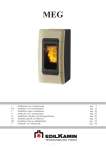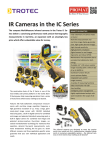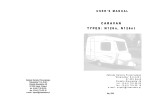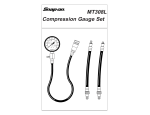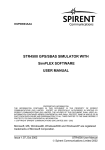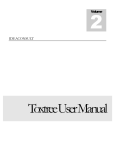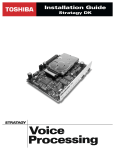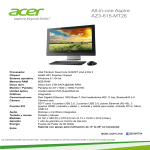Download Navitec 06 paper
Transcript
EUTERPE - EUROPEAN TEST CENTRE FOR RECEIVER PERFORMANCE EVALUATION David Jiménez-Baños(1), Michel Tossaint(1), Jean-Luc Gerner(1), Rafael Lucas-Rodríguez(2) (1) Radio Navigation Systems and Techniques section (TEC-ETN) European Space Agency ESA/ESTEC Keplerlaan 1, 2200 AG Noordwijk The Netherlands Email: [email protected], [email protected], [email protected] (2) Navigation Applications and User Services Office Directorate of EU and Industrial Programmes Navigation Department European Space Agency ESA/ESTEC Keplerlaan 1, 2200 AG Noordwijk The Netherlands Email: [email protected] ABSTRACT EUropean TEst centre for Receiver PErformance evaluation (EUTERPE) is an industry independent centre being set-up by the European Space Agency (ESA) with the purpose of supporting the testing of satellite navigation receivers using EGNOS and Galileo. The purpose of this paper is to give detailed information on the tests performed at the centre. INTRODUCTION During last decade Global Navigation Satellite Systems (GNSS) receivers have reached the mass-market. From the high-end geodetic applications to in-car navigation GNSS receivers have a strong penetration in our society. However, when the common user wants to purchase a new receiver he faces the question of which one is the correct choice for his needs. Usually, this choice is based in what the user can find about a particular product; i.e. advertisements, vendor advice, word of mouth, etc. These sources of information may not always be sufficient to an application designer. The aim of EUTERPE (EUropean TEst centre for Receiver PErformance evaluation) is to ease this choice in the future. GNSS receivers’ reviews can be found in specialized journals and a wide range of websites on the Internet. Although these reviews have proven really useful, a lack of standardization has translated into a difficult work when comparing receivers. Thus, having a complete set of reference tests that can be repeated for every receiver generating an easy to compare review is the main goal of EUTERPE. On the other hand, every receiver has its own application and this should be taken into account when comparing receivers. Moreover, testing all kind of receivers could be a huge work requiring an enormous amount of manpower and specialized equipment. Thus, during the first stage of the centre these tests have been narrowed to a particular type of receivers: GPS/EGNOS receivers for non-safety of life applications. Furthermore, in this initial phase of the centre the tests comprise only the compatibility of the GNSS receivers with the EGNOS system, i.e. proper implementation of EGNOS message processing algorithms. However, more tests can be performed in collaboration with the manufacturers depending on their needs. These tests include but are not limited to positioning errors, acquisition and tracking thresholds, performance under interfering scenarios, multipath and near-far mitigation, indoor performance, etc. These tests are performed using signal simulators capable to provide a realistic simulation. The main objective of the Centre will be to provide the receiver manufacturers with a “statement of compliance” and in this way offer them the support needed for the compatibility of the receivers with European GNSS. In an initial phase this centre has been setup at the European Space Technology Center (ESTEC) within the facilities of the European Navigation Laboratory. This has allowed a quick access to a wide range of advanced equipments and systems needed for the realisation of the tests. A description of the tests alongside with the tools used, the way of performing them, the purpose and the expected results will be deeply explained. Some of the key points for the credibility of these tests are the tools used in the day to day work at the centre. Hence, a profound explanation of the equipment used at the centre will be given paying special attention to those that have been developed in-house. These tools are unique and have been designed for an efficient and unbiased testing. Although the basic message set used for testing is an EGNOS file, compatibility with WAAS is also verified. Moreover, once Galileo receivers become available in the market the centre will move on to tests these receivers as well. DESCRIPTION OF THE CURRENT TESTS As it has been said the first test plan only checks the compatibility of the receivers with the current EGNOS broadcasting. That being said, the first goal of the centre was obtaining a testing methodology that works on the vast majority of receivers. Normally, there is no direct way of checking whether the receiver is correctly implementing the algorithms to decode the EGNOS messages. However, this can be tested in an indirect way for most of the cases. The main idea behind this is that a change in an EGNOS message should affect the position fix the receiver is providing. The actual method to test the receiver consists in logging the position fixes and the satellites the receiver is using for position computation during a certain period of time (current test are performed during one hour). The GPS and EGNOS signals are fed to the receiver coming from a GNSS simulator. Every test consists of two parts: the first one using a simulation in line with the current GPS/EGNOS real life signals (the baseline), and the second one modifying the EGNOS messages in the baseline. In this way, some results can be extracted from the logged data that allow us to detect a wrong behaviour of the receiver for a certain EGNOS message. The results are given in a pass/not pass form depending on the comparison of the logged data between the baseline and modified simulation. Basically, what are compared are the position fixes and the satellites used for computation of this fixes. The current test plan currently consists of twenty different tests that check the compatibility of the receiver with different aspects of the EGNOS messages: Table 1 Current tests Test 1 SBAS message involved MT1 2 MT2-5 3 4 5 6 7 8 9 10 11 12 13 MT2-5 MT2-5 MT2-5 MT6 MT6 MT25 MT25 MT25 MT25 MT24 MT18 14 15 16 17 18 19 20 MT26 MT26 MT26 MT26 MT26 MT2-5 MT2-5 Purpose Type of result PRN Mask assignments. Change in monitored satellites. Fast corrections (Use of PRC and RRC). Implicitly taken care in tests 4 and 6. Satellites set to “do not use” or “not monitored”. Use of IODP. Time out of fast corrections. Satellites set to “do not use” or “not monitored”. Use of IODF. Use of slow corrections. Use of velocity code. Use of IODP. Time out of slow corrections. Use of mixed fast and slow corrections. Ionospheric grid definition. Change in monitored grid points. Use of GIVD. Grid points set to “do not use” or “not monitored”. USE of IODI. Time out of ionospheric corrections. Interpolation of IGPs. Switching GEO Satellites. Switching SBAS Operator (WAAS and EGNOS). Position fixes. Position fixes. Position fixes. Position fixes. Position fixes. Position fixes. Position fixes. Position fixes. Position fixes. Position fixes. Implicitly taken care in test 16. Position fixes. Position fixes. Position fixes. Position fixes. Position fixes. Satellites used for position. Position fixes. Position fixes. It is important to note that these tests are only the first implementation of the test plan. Although they have been proposed to check all the aspects of the EGNOS current broadcasting for non-safety of life receivers this test plan should evolve with feedback obtained from manufacturers as well as from the testing of receivers. An Example: Test 2 - Fast Corrections As an example a particular test is explained in detail here. One of the test checks the use of the Fast corrections present in messages MT2 to MT5. Fast corrections are used to correct for the fast changing orbit and clock errors of the GPS satellites. Testing whether the receiver is implementing the Range-rate corrections (RRC) computations correctly is only possible with access to the correction data. It is assumed that receivers are using smoothing filters, which mask the effect of RRCs. What can be tested is whether fast corrections are used at all. For this purpose maximum values are used. First of all, the receiver is connected to the GNSS simulator (see next section) and the baseline simulation is run. The baseline simulation comprises a GPS constellation with EGNOS corrections, as already mentioned the baseline spans during one hour (although this time can be easily shortened or extended). In this baseline, the Fast corrections are set to zero as the simulated GPS constellation in this case is generated without rapidly changing clock and orbit errors. The positions fixes the receiver is producing are logged during the whole simulation time. Of course, the receiver has to be setup in SBAS mode in case it doesn’t switch to it automatically. During the second phase of this test, the receiver is once again connected to the GNSS simulator, but this time a modified version of the baseline simulation is run. This simulation is generated using the baseline one by changing the values of the fast corrections in messages MT2-5, however the GPS constellation is left untouched. Thus, this simulation is feeding wrong fast corrections to the receiver. Actually, fast corrections are set to the maximum value +256 m for half of the GPS constellation and to the minimum value -256 m for the other half. This will obviously lead the receiver to provide wrong position fixes. Indeed, that is what wants to be achieved as it will be the way to know that the receiver is applying the SBAS fast corrections. Again, the position fixes are logged during the whole simulation. The third step is to compare the two datasets (the logged position fixes). The position fixes obtained with the baseline scenario should match the simulated position with certain receiver accuracy. It should be noted that this accuracy is out of the scope of these tests. The position fixes obtained with the modified scenario should differ significantly from the simulated position as well as from the position obtained with the baseline and the receiver will pass this test. In case, the position fixes obtained with the modified simulation match the simulated position with certain accuracy the receiver will not pass this test as it will be clearly not implementing the algorithms to apply the fast corrections. TESTING TOOLS As important as having a consolidated test plan that can be easily repeated in an unbiased manner are the equipment and tools used to perform these tests. The initial deployment of EUTERPE into the facilities of the European Navigation Laboratory has allowed quick access to key tools used in the tests. The main equipment needed to perform the current tests is a Spirent STR4760 GNSS simulator, generating GPS/EGNOS ranging signals and EGNOS messages. Given the nature of these tests, some options needed were not available in the current version of the simulator. Basically, the tests are performed generating two EGNOS datasets that differ only in some bits and comparing the outputs of the receiver under test. Although the Spirent software allows certain configurability of the generated EGNOS messages our tests required access at bit level, which is not a built-in feature. However, the simulator provides a very flexible way (although not straightforward) to modify SBAS messages at bit level. It is possible to load in the simulator an external SBAS file in the simulator with the exact dataset we want to generate, thus allowing the user to modify the bits of the frames at will. The loaded file has to be in a specific Spirent format (basically hexadecimal pairs). These messages can come from different sources. Mainly, two different sources are currently implemented in the test setup, datasets obtained from the EMS (EGNOS message server) and datasets coming from the Spirent simulator. Nevertheless, more sources will be implemented in the future system in an easy way. As already discussed in the previous section two simulations are run for every test, these two simulations use a different EGNOS data file. The first simulation or baseline scenario is actually run only once as the EGNOS dataset remains fixed for all the tests. This baseline scenario can be obtained in two ways: using an EMS file or using the built-in SBAS generation of the Spirent simulator. The second simulation of every test uses a modified version of the baseline scenario designed for every specific test, thus obtaining in fact 20 EGNOS data files (one for every test). These data files are generated using part of in-house developed software called EUTERPE Tools: the Nav Data Converter. This software loads an EGNOS data file in EMS or Spirent proprietary format and allows the user to manipulate the messages and produce a new data file. This new data file is loaded in the simulator and the test can be performed. The test setup is depicted in Fig. 1. PC 1 SimGEN software PC 2 Euterpe tools Nav Data Converter Spirent STR4760 Rx under test Fig. 1 EUTERPE test setup. The steps involved in the generation of the modified data file are summarized in the following list (this list is assuming that the source use for the EGNOS messages is the Spirent simulator): • • • The baseline scenario has to be run first using the “dump navigation data” in SimGEN software. The next step involves decoding the dumped data in PC1 to extract the SBAS messages in Spirent hex format. The Spirent hex file is loaded in PC 2 and the Nav Data converter is used to generate the modified file. RESULTS This section provides some results obtained with a GPS/SBAS receiver. It should be noted that these results are part of the first tests and are just an example of the current test methodology. The methodology already explained is constantly evolving and it will be modified with the feedback obtained from receiver manufacturers. The first test shown here is the one already explained in detail in the previous section: test 2 Fast Corrections. The receiver was connected to the Spirent simulator and the baseline simulation was run logging the position fixes in PC 2. To obtain the modified simulation the dumped data in PC1 coming from the Spirent simulator was used as discussed in the previous section. Afterwards, using the Nav Data Converter of the EUTERPE tools the modified simulation was produced and the receiver was checked again logging the position fixes in PC2. These logged position fixes where processed using Pegasus Convertor [4] to be easily handled by Matlab in order to produce the comparison. The test duration was 50 minutes. The position fixes obtained with the baseline and modified simulation can be seen in Fig. 2. As it can be seen the position fixes obtained with the baseline simulation are concentrated around the simulated position whereas the ones obtained with the modified simulation moved away from it due to the wrong fast corrections setup in the SBAS messages. The mean difference in X was 255.73 m and 820.25 m in Y. Thus, the receiver passed this test as it implements the fast corrections algorithms. 6 4.715 Fast corrections test x 10 4.7149 Y cartesian position (m) 4.7148 4.7147 Baseline Modified 4.7146 4.7145 4.7144 4.7143 4.7142 4.7141 4.714 4.2444 4.2445 4.2446 4.2447 4.2448 X cartesian position (m) 4.2449 4.245 6 x 10 Fig. 2 Fast corrections test A plot showing the behaviour of the receiver over time is also depicted in Fig. 3. As it can be seen the positions fixes obtained with the baseline always stay around the simulated position whereas the ones obtained with the modified simulation move away from it. Fast corrections test 6 x 10 Y cartesian position (m) 4.715 4.7148 Modified Baseline 4.7146 4.7144 4.7142 4.714 4.245 2.84 4.2448 2.83 6 x 10 2.82 4.2446 X cartesian position (m) 4.2444 2.8 5 x 10 2.81 Time in GPS seconds Fig. 3 Fast corrections test along time The result for another test is shown in Fig. 4, this test is test number 3 in Table 1. This test checks the proper implementation of user differential range error (UDRE) processing algorithms for messages MT2-5. When satellites are set to do not use or not monitored (UDRE tabular value set to 14 or 15) they should not be used for the position computation. The approach is similar to the previous test where the position fixes are used to indirectly check this processing. A simulation is run changing the UDRE values to 15 for all the visible satellites after the middle of it. This change causes that the receiver is unable to give a position fix as all the visible satellites are set as “do not use” for position computation. In Fig. 4 the first 45 min of data logging are plotted. Position vs messages 2-5 Udrei changes Latitude in degrees 50 40 30 20 10 0 0 500 1000 1500 2000 2500 3000 0 500 1000 1500 2000 2500 3000 Longitudees in degre 8 6 4 2 0 15 UDREI value 10 Satellite 1 Satellite 8 5 0 0 500 1000 1500 Simulation time (seconds) 2000 2500 3000 Fig. 4 Satellites set to “do not use” or “not monitored” test along time CALIBRATION AND RESULTS PUBLICATION As it has been noted EUTERPE is in an initial phase and this implies that all the tools and the test methodology is still under a validation stage. A lot of effort has been put in building the tools and the test methodology minimizing possible errors. However, it is important to calibrate and validate all the equipment as well as the test plan to further eliminate any fault. To do so, the test methodology is evolving constantly after every test is performed. Moreover, collaboration with manufacturers in the interpretation of the results as well as their opinion on the testing methods is a key element for the development of this centre in these early stages. All the tests and results will be discussed with the manufacturers before their publication. Regarding the calibration and validation of the equipment and testing tools, one of the simplest and most robust ways of doing so is crosschecking the results of different receivers. Furthermore, doing a periodical test of the same receiver should provide also a valuable mean to validate the testing tools, i.e. the results obtained should be the same when using the same receiver. Besides, the STR4760 simulator is controlled externally: the simulator is tested and calibrated periodically by the manufacturer Spirent communications Ltd. . GNSS USER EQUIPMENT TESTING COVERING FUTURE MODERNISATIONS EUTERPE is in its early beginning and thus is evolving rapidly. Everyday a lot of feedback is obtained from the testing of receivers. In addition, manufacturer’s comments are always taken into account in the fine tuning of the tests procedures. As an example of such fine tuning, one aspect of the testing is currently planned for change: the results shown in this paper where obtained using Pegasus Convertor that extracts the needed logged data from the specific format of the receiver and leaves it in coma separated values (CSV) format files. The current intention is to move to NMEA format [2] as it is more standardized and will provide a way to obtain the logged data in an easy way for a vast amount of receivers. In addition, EUTERPE will evolve to test a broader range of receivers. For example, Galileo receivers once they start to be available in the market. More tests will be added to the test plan specifically designed to check particular characteristics of receivers meant for different applications. CONCLUSIONS Testing GNSS receivers in a repeatable way is not a trivial task and requires unique tools and a planned test strategy that works on the vast majority of receivers. Moreover, human interaction tends to lead to subjective measurements and the possibility of errors. Along this paper we have presented the test strategy followed in EUTERPE which tries to minimize these problems by using internally developed tools and following a test plan that leaves no room to subjectivity (the tests are either a pass or a not pass). A strong point that has been discussed in the paper is the need of interaction with manufacturers and the will of the Centre to discuss and implement the strategy of it matching their needs. Thus, obtaining receivers to test and discussing the results could prove useful for both parties. Manufacturers are invited to contact the authors with any feedback, comment or receiver to test. Furthermore, the arrival of Galileo will flood the market shelves with new receivers designed for it. When this moment arrives this Centre will move forward to test the compatibility of these receivers with the Galileo signals. ACKNOWLEDGMENTS The authors want to thank the colleagues of the Radionavigation Section of the Technical Directorate of ESA and of the Navigation Applications and User Services Office of the Navigation Department. Special thanks to Matthieu Delas, ESA Young Graduate Trainee in the Navigation Applications and User Services Office of the Navigation Department for all his contributions to the EUTERPE day to day work. REFERENCES [1] DO-229C, Minimum Operational Performance Standards for Global Positioning System/Wide Area Augmentation System Airborne Equipment, Issued 11-28-01 s Supersedes DO-229B s Errata s Issued 8-16-02, prepared by SC-159. [2] NMEA 0183, National Maritime Electronics Association, Standard for interfacing Maritime Electronic devices, July 2000, Version 3.0. [3] Spirent STR4760 SIMGEN Signal simulator user manual, Spirent communications Ltd, issue 1-14, April 2005. [4] PEGASUS Software User Manual: Module Convertor, GNSS Tools Team, issue M, January 2006.







